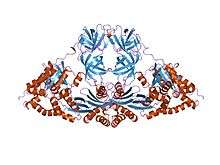UBA protein domain
| UBA | |||||||||
|---|---|---|---|---|---|---|---|---|---|
 elongation factor complex ef-tu/ef-ts from escherichia coli | |||||||||
| Identifiers | |||||||||
| Symbol | UBA | ||||||||
| Pfam | PF00627 | ||||||||
| Pfam clan | CL0214 | ||||||||
| InterPro | IPR000449 | ||||||||
| PROSITE | PDOC50030 | ||||||||
| SCOP | 1efu | ||||||||
| SUPERFAMILY | 1efu | ||||||||
| CDD | cd00194 | ||||||||
| |||||||||
In molecular biology, the protein domain UBA is short for ubiquitin-associated domains. Ubiquitin is a signal added to an incorrectly folded protein, which allows it to be degraded by the proteasome, and the amino acid constituents can be recycled.
Function
This family of proteins is involved in a variety of additional cell processes, such as nucleotide excision repair (NER), spindle pole body duplication, and cell growth.[1]
Protein degradation via the ubiquitin proteasome system (UPS) allows the cell to selectively negatively regulate intracellular proteins. Protein degradation helps to maintain protein quality control, signalling, and cell cycle progression.[2][3] UBA has be proposed to limit ubiquitin chain elongation and to target polyubiquitinated proteins to the 26S proteasome for degradation.[4] They have been identified in modular proteins involved in protein trafficking, DNA repair, proteasomal degradation, and cell cycle regulation. UBA bind to ubiquitin and aids all the cellular processes involved with ubiquitin; this includes:
- Antigen processing
- Apoptosis
- Biogenesis of organelles
- Cell cycle and division
- DNA transcription and DNA repair
- Differentiation and development
- Immune response and inflammation
- Neural and muscular degeneration
- Morphogenesis of neural networks
- Modulation of cell surface receptors, ion channels and the secretory pathway
- Response to stress and extracellular modulators
- Ribosome biogenesis
- Viral infection
Localisation
The ubiquitin-associated (UBA) protein domain is found to be localized in the cytoplasm and nucleus.[4]
Structure
UBA domains are a commonly occurring sequence motif of approximately 45 amino acid residues.[5]
Examples
The human homologue of yeast Rad23A is one example of a nucleotide excision-repair protein that contains both an internal and a C-terminal UBA domain. The solution structure of human Rad23A UBA(2) showed that the domain forms a compact three-helix bundle.[6]
Comparison of the structures of UBA(1) and UBA(2) reveals that both form very similar folds and have a conserved large hydrophobic surface patch which may be a common protein-interacting surface present in diverse UBA domains. Evidence that ubiquitin binds to UBA domains leads to the prediction that the hydrophobic surface patch of UBA domains interacts with the hydrophobic surface on the five-stranded beta-sheet of ubiquitin.[7]
This domain is similar in sequence to the N-terminal domain of translation elongation factor EF1B (or EF-Ts) from bacteria, mitochondria and chloroplasts.
More information about EF1B (EF-Ts) proteins can be found at Protein of the Month: Elongation Factors .
References
- ↑ Su V, Lau AF (2009). "Ubiquitin-like and ubiquitin-associated domain proteins: significance in proteasomal degradation.". Cell Mol Life Sci. 66 (17): 2819–33. doi:10.1007/s00018-009-0048-9. PMC 2725189
 . PMID 19468686.
. PMID 19468686. - ↑ Gomez TA, Kolawa N, Gee M, Sweredoski MJ, Deshaies RJ (2011). "Identification of a functional docking site in the Rpn1 LRR domain for the UBA-UBL domain protein Ddi1.". BMC Biol. 9: 33. doi:10.1186/1741-7007-9-33. PMC 3126750
 . PMID 21627799.
. PMID 21627799. - ↑ Tse MK, Hui SK, Yang Y, Yin ST, Hu HY, Zou B, et al. (2011). "Structural analysis of the UBA domain of X-linked inhibitor of apoptosis protein reveals different surfaces for ubiquitin-binding and self-association.". PLoS ONE. 6 (12): e28511. doi:10.1371/journal.pone.0028511. PMC 3240630
 . PMID 22194841.
. PMID 22194841. - 1 2 Li J, Chu H, Zhang Y, Mou T, Wu C, Zhang Q, et al. (2012). "The rice HGW gene encodes a ubiquitin-associated (UBA) domain protein that regulates heading date and grain weight.". PLoS ONE. 7 (3): e34231. doi:10.1371/journal.pone.0034231. PMC 3311617
 . PMID 22457828.
. PMID 22457828. - ↑ Hofmann K, Bucher P (May 1996). "The UBA domain: a sequence motif present in multiple enzyme classes of the ubiquitination pathway". Trends Biochem. Sci. 21 (5): 172–3. doi:10.1016/S0968-0004(96)30015-7. PMID 8871400.
- ↑ Dieckmann T, Withers-Ward ES, Jarosinski MA, Liu CF, Chen IS, Feigon J (December 1998). "Structure of a human DNA repair protein UBA domain that interacts with HIV-1 Vpr". Nat. Struct. Biol. 5 (12): 1042–7. doi:10.1038/4220. PMID 9846873.
- ↑ Mueller TD, Feigon J (June 2002). "Solution structures of UBA domains reveal a conserved hydrophobic surface for protein-protein interactions". J. Mol. Biol. 319 (5): 1243–55. doi:10.1016/S0022-2836(02)00302-9. PMID 12079361.
This article incorporates text from the public domain Pfam and InterPro IPR000449